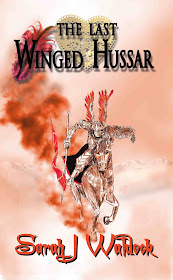So I hope you are all surviving Covid 19 well enough, I feel a little bit guilty that I've been enjoying myself with the peace and quiet, to the point that I'm 2/3 of the way through my 6th novel written since March 11th. [finished the 5th on May 12th; this one is a bit slower].
So what happened?
Well, I recently discovered the band 'Sabaton', who are a Swedish metal band who write songs about historical battles, heroes and so on, and heard their song 'The Winged Hussars Arrive', about the Polish heavy cavalry who went into battle with wings. The song is about the seige of Vienna, when the then-king of the Poles, Jan III Sobieski led his men over the top of the Kahlenberg mountain to charge on the Ottoman Turks, relieving the siege.
The winged hussars arrived
And I was captivated, read more, and discovered that the Winged Hussars were disbanded in 1776, shortly before Poland, as a country, ceased to exist.
Well, that almost demanded the title 'The Last Winged Hussar' and Wojciech Skrzydło, the maverick red hussar was born.
Um... and I might have been watching too many old YouTube Lone Ranger episodes as well.
 |
| this is a screen capture from the dong, I think it's from Ogiem i Meciem, a Hussar film |
 |
| the above 3 are from Day of the Siege |
 |
| re-enactors |
Moreover the Polish Szlachta, nobility wore such AWESOME clothing still when the rest of Europe was corseted, bewigged and looked like coxcombs, they were stalking around in comfortable looking brocaded zupans and kontuszs with outsize sabres looking like heroes.
 |
| and I might just have got ideas for secondary characters from some of the stills I took .... |
So, what's it about?
The Polish-Lithuanian Commonwealth 1776; the famed Winged
Hussars, renowned for their valour and honour, have been disbanded as
obsolete.
Wojciech Płodziewicz feels cut adrift. He decides that the only way to save his
honour is to continue as a lone winged knight, righting wrongs.
He does not expect, on his first mission, to discover a
damsel in distress, who turns out to be extremely capable and spirited and with
a personal reason to dislike the treacherous wojewoda, Władimir Trąbka. Wojciech has sworn to overthrow and have him replaced. Irenka goes with him when his mission is
accomplished. After other adventures a final showdown with Trąbka leaves Irenka
free to marry her Winged Hussar.
This has taken so much research, and it has been the greatest fun. Thanks to Aleksandra Leśniewska for letting me pick your brains and putting me right as needed, and thanks to Aleksandra I also finally finished the name book! it's been a wonderful journey and I seem to be happily riding on ... and in the window my Covid rainbow has a silhouette winged hussar on it
And then the sequels kept arriving in my head ...




Sarah, you are amazing! Fab cover too.
ReplyDeletethank you, Charlotte! I feel a little guilty about enjoying myself so thoroughly when other people are not ... still I've been posting them on the other blog for people to read the drafts until I actually publish so there's at least free entertainment while I edit and improve them!
DeleteSabaton is a great band as well - I got to listen to them on the 2015 tour with Nightwish and Delain. Shared your Winged Hussar stories with several of my SCA re-enactor friends who have Polish personas so that they could enjoy your stories as well.
ReplyDeletewow, what a treat!
Deletethank you very much, I hope they they enjoyed, It's something I'd love to be a part of.
Polish szlachta created the legend of Sarmatian origin and developed very specific culture. The Wing Hussars were part of it. One of characteristic were funerals which left us the funeral portraits. So we can look at them as if they would live here
ReplyDeletehttps://en.wikipedia.org/wiki/Coffin_portrait The portraits were meant to represent the deceased at their own funeral and thus the painters always tried to portray the dead as if they had still been alive. The portraits stared directly at the viewer, checking whether all the gathered relatives cried well enough and praised the dead sufficiently.
wow, thank you very much, that was a part of the culture I missed.
DeletePolish szlachta created the legend of Sarmatian origin and developed very specific culture. The Wing Hussars were part of it. One of characteristic were funerals which left us the funeral portraits. So we can look at them as if they would live here
ReplyDeletehttps://en.wikipedia.org/wiki/Coffin_portrait The portraits were meant to represent the deceased at their own funeral and thus the painters always tried to portray the dead as if they had still been alive. The portraits stared directly at the viewer, checking whether all the gathered relatives cried well enough and praised the dead sufficiently.